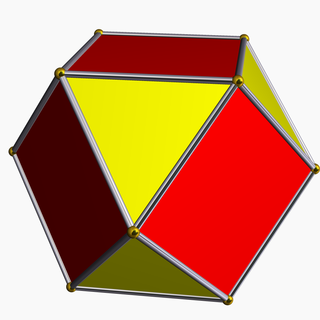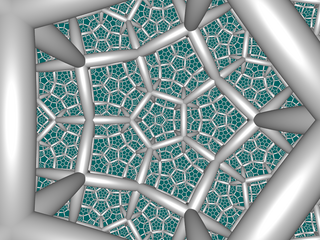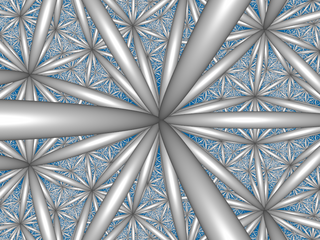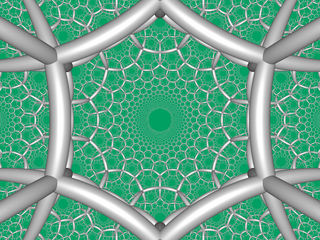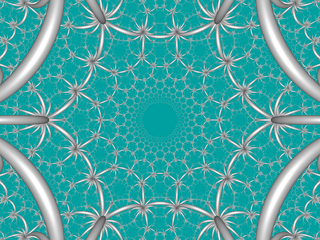This article includes a list of references, related reading or external links, but its sources remain unclear because it lacks inline citations .(March 2015) (Learn how and when to remove this template message) |

In geometry, runcination is an operation that cuts a regular polytope (or honeycomb) simultaneously along the faces, edges, and vertices, creating new facets in place of the original face, edge, and vertex centers.[ citation needed ]

Geometry is a branch of mathematics concerned with questions of shape, size, relative position of figures, and the properties of space. A mathematician who works in the field of geometry is called a geometer.

In mathematics, a regular polytope is a polytope whose symmetry group acts transitively on its flags, thus giving it the highest degree of symmetry. All its elements or j-faces — cells, faces and so on — are also transitive on the symmetries of the polytope, and are regular polytopes of dimension ≤ n.

In geometry, a honeycomb is a space filling or close packing of polyhedral or higher-dimensional cells, so that there are no gaps. It is an example of the more general mathematical tiling or tessellation in any number of dimensions. Its dimension can be clarified as n-honeycomb for a honeycomb of n-dimensional space.
Contents
It is a higher order truncation operation, following cantellation, and truncation.

In geometry, a cantellation is a 2nd order truncation in any dimension that bevels a regular polytope at its edges and at its vertices, creating a new facet in place of each edge and of each vertex. Cantellation also applies to regular tilings and honeycombs. Cantellating is also rectifying its rectification.

In geometry, a truncation is an operation in any dimension that cuts polytope vertices, creating a new facet in place of each vertex. The term originates from Kepler's names for the Archimedean solids.
It is represented by an extended Schläfli symbol t0,3{p,q,...}. This operation only exists for 4-polytopes {p,q,r} or higher.

In geometry, the Schläfli symbol is a notation of the form {p,q,r,...} that defines regular polytopes and tessellations.

In geometry, a 4-polytope is a four-dimensional polytope. It is a connected and closed figure, composed of lower-dimensional polytopal elements: vertices, edges, faces (polygons), and cells (polyhedra). Each face is shared by exactly two cells.
This operation is dual-symmetric for regular uniform 4-polytopes and 3-space convex uniform honeycombs.

In geometry, a uniform 4-polytope is a 4-polytope which is vertex-transitive and whose cells are uniform polyhedra, and faces are regular polygons.

In geometry, a convex uniform honeycomb is a uniform tessellation which fills three-dimensional Euclidean space with non-overlapping convex uniform polyhedral cells.
For a regular {p,q,r} 4-polytope, the original {p,q} cells remain, but become separated. The gaps at the separated faces become p-gonal prisms. The gaps between the separated edges become r-gonal prisms. The gaps between the separated vertices become {r,q} cells. The vertex figure for a regular 4-polytope {p,q,r} is an q-gonal antiprism (called an antipodium if p and r are different).

In geometry, a prism is a polyhedron comprising an n-sided polygonal base, a second base which is a translated copy of the first, and n other faces joining corresponding sides of the two bases. All cross-sections parallel to the bases are translations of the bases. Prisms are named for their bases, so a prism with a pentagonal base is called a pentagonal prism. The prisms are a subclass of the prismatoids.

In geometry, a vertex figure, broadly speaking, is the figure exposed when a corner of a polyhedron or polytope is sliced off.

In geometry, an n-sided antiprism is a polyhedron composed of two parallel copies of some particular n-sided polygon, connected by an alternating band of triangles. Antiprisms are a subclass of the prismatoids and are a (degenerate) type of snub polyhedron.
For regular 4-polytopes/honeycombs, this operation is also called expansion by Alicia Boole Stott, as imagined by moving the cells of the regular form away from the center, and filling in new faces in the gaps for each opened vertex and edge.

In geometry, expansion is a polytope operation where facets are separated and moved radially apart, and new facets are formed at separated elements. Equivalently this operation can be imagined by keeping facets in the same position but reducing their size.

Alicia Boole Stott was an Irish-English mathematician. Despite never holding an academic position, she made a number of valuable contributions to the field, receiving an honorary doctorate from the University of Groningen. She is best known for coining the term "polytope" for a convex solid in four dimensions, and having an impressive grasp of four-dimensional geometry from a very early age.
Runcinated 4-polytopes/honeycombs forms:
| Schläfli symbol Coxeter diagram | Name | Vertex figure | Image |
|---|---|---|---|
| Uniform 4-polytopes | |||
| t0,3{3,3,3} | Runcinated 5-cell |  |  |
| t0,3{3,3,4} | Runcinated 16-cell (Same as runcinated 8-cell) |  |   |
| t0,3{3,4,3} | Runcinated 24-cell |  |  |
| t0,3{3,3,5} | Runcinated 120-cell (Same as runcinated 600-cell) |  |  |
| Euclidean convex uniform honeycombs | |||
| t0,3{4,3,4} | Runcinated cubic honeycomb (Same as cubic honeycomb) |  |  |
| Hyperbolic uniform honeycombs | |||
| t0,3{4,3,5} | Runcinated order-5 cubic honeycomb |  | |
| t0,3{3,5,3} | Runcinated icosahedral honeycomb |  | |
| t0,3{5,3,5} | Runcinated order-5 dodecahedral honeycomb |  | |
